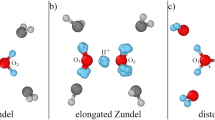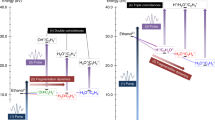Abstract
A microscopic picture of hydrogen-bond structure and dynamics in ion hydration shells remains elusive. Small ion–dihydrate molecular complexes are ideal systems with which to investigate the interplay and competition between ion–water and water–water interactions. Here, state-of-the-art quantum dynamics simulations provide evidence for tunnelling in hydrogen-bond rearrangements in the iodide–dihydrate complex and show that it can be controlled through isotopic substitutions. We find that the iodide ion weakens the neighbouring water–water hydrogen bond, leading to faster water reorientation than in the analogous water trimer. These faster dynamics, which are apparently at odds with the slowdown observed in the first hydration shell of iodide in solution, can be traced back to the presence of a free OH bond in the iodide–dihydrate complex, which effectively triggers the overall structural rearrangements within it. Besides providing indirect support for cooperative hydrogen-bond dynamics in iodide solutions, the analysis presented here suggests that iodide ions may accelerate hydrogen-bond rearrangements at aqueous interfaces, where neighbouring water molecules can be undercoordinated.
This is a preview of subscription content, access via your institution
Access options
Access Nature and 54 other Nature Portfolio journals
Get Nature+, our best-value online-access subscription
$29.99 / 30 days
cancel any time
Subscribe to this journal
Receive 12 print issues and online access
$259.00 per year
only $21.58 per issue
Buy this article
- Purchase on Springer Link
- Instant access to full article PDF
Prices may be subject to local taxes which are calculated during checkout





Similar content being viewed by others
Code availability
The computer codes used in this study are available from the authors upon request.
Data availability
Any data generated and analysed for this study that are not included in this Article and its Supplementary Information are available from the authors upon request.
References
Sneen, R. A. Substitution at a saturated carbon atom. XVII. Organic ion pairs as intermediates in nucleophilic substitution and elimination reactions. Acc. Chem. Res. 6, 46–53 (1973).
Pregel, M., Dunn, E., Nagelkerke, R., Thatcher, G. & Buncel, E. Alkali–metal ion catalysis and inhibition in nucleophilic displacement reaction of phosphorus–sulfur–and carbon–based esters. Chem. Soc. Rev. 24, 449–455 (1995).
Collins, K. D., Neilson, G. W. & Enderby, J. E. Ions in water: characterizing the forces that control chemical processes and biological structure. Biophys. Chem. 128, 95–104 (2007).
Kunz, W. Specific ion effects in colloidal and biological systems. Curr. Opin. Colloid Interface Sci. 15, 34–39 (2010).
Nostro, P. L. & Ninham, B. W. Hofmeister phenomena: an update on ion specificity in biology. Chem. Rev. 112, 2287–2322 (2012).
Tobias, D. J., Stern, A. C., Baer, M. D., Levin, Y. & Mundy, C. J. Simulation and theory of ions at atmospherically relevant aqueous liquid–air interfaces. Annu. Rev. Phys. Chem. 64, 339–359 (2013).
Lehtipalo, K. et al. The effect of acid–base clustering and ions on the growth of atmospheric nano-particles. Nat. Commun. 7, 11594 (2016).
Winter, M. & Brodd, R. J. What are batteries, fuel cells, and supercapacitors? Chem. Rev. 104, 4245–4270 (2004).
Pollard, T. P. & Beck, T. L. Toward a quantitative theory of hofmeister phenomena: from quantum effects to thermodynamics. Curr. Opin. Colloid Interface Sci. 23, 110–118 (2016).
Bakker, H., Kropman, M. & Omta, A. Effect of ions on the structure and dynamics of liquid water. J. Phys. Condens. Matter 17, S3215 (2005).
Jungwirth, P. & Tobias, D. J. Specific ion effects at the air/water interface. Chem. Rev. 106, 1259–1281 (2006).
Robertson, W. H. & Johnson, M. A. Molecular aspects of halide ion hydration: the cluster approach. Annu. Rev. Phys. Chem. 54, 173–213 (2003).
Ayala, R., Martinez, J. M., Pappalardo, R. R. & Marcos, E. S. Study of the stabilization energies of halide–water clusters: an application of first-principles interaction potentials based on a polarizable and flexible model. J. Chem. Phys. 121, 7269–7275 (2004).
Kamarchik, E. & Bowman, J. M. Quantum vibrational analysis of hydrated ions using an ab initio potential. J. Phys. Chem. A 114, 12945–12951 (2010).
Wang, X.-G. & Carrington, T. Jr. Rovibrational levels and wavefunctions of Cl−H2O. J. Chem. Phys. 140, 204306 (2014).
Kamarchik, E., Toffoli, D., Christiansen, O. & Bowman, J. M. Ab initio potential energy and dipole moment surfaces of the F−(H2O) complex. Spectrochim. Acta A 119, 59–62 (2014).
Sarka, J., Lauvergnat, D., Brites, V., Császár, A. G. & Léonard, C. Rovibrational energy levels of the F−(H2O) and F−(D2O) complexes. Phys. Chem. Chem. Phys. 18, 17678–17690 (2016).
Bajaj, P., Wang, X.-G., Carrington, T. Jr. & Paesani, F. Vibrational spectra of halide–water dimers: insights on ion hydration from full-dimensional quantum calculations on many-body potential energy surfaces. J. Chem. Phys. 148, 102321 (2018).
Wolke, C. T. et al. Thermodynamics of water dimer dissociation in the primary hydration shell of the iodide ion with temperature-dependent vibrational predissociation spectroscopy. J. Phys. Chem. A 119, 1859–1866 (2015).
Yang, N., Duong, C. H., Kelleher, P. J., Johnson, M. A. & McCoy, A. B. Isolation of site-specific anharmonicities of individual water molecules in the I−(H2O)2 complex using tag-free, isotopomer selective IR-IR double resonance. Chem. Phys. Lett. 690, 159–171 (2017).
Cheng, X. & Steele, R. P. Efficient anharmonic vibrational spectroscopy for large molecules using local-mode coordinates. J. Chem. Phys. 141, 104105 (2014).
Cheng, X., Talbot, J. J. & Steele, R. P. Tuning vibrational mode localization with frequency windowing. J. Chem. Phys. 145, 124112 (2016).
Wang, Y. & Bowman, J. M. Ab initio potential and dipole moment surfaces for water. II. Local-monomer calculations of the infrared spectra of water clusters. J. Chem. Phys. 134, 154510 (2011).
Bajaj, P., Götz, A. W. & Paesani, F. Toward chemical accuracy in description of ion–water interactions through many-body representations. I. Halide–water dimer potential energy surfaces. J. Chem. Theory Comput. 12, 2698–2705 (2016).
Brown, S. E. et al. Monitoring water clusters ‘melt’ through vibrational spectroscopy. J. Am. Chem. Soc. 139, 7082–7088 (2017).
Pugliano, N. & Saykally, R. J. Measurement of quantum tunneling between chiral isomers of the cyclic water trimer. Science 257, 1937–1940 (1992).
Keutsch, F. N. & Saykally, R. J. Water clusters: untangling the mysteries of the liquid, one molecule at a time. Proc. Natl Acad. Sci. USA 98, 10533–10540 (2001).
Keutsch, F. N., Cruzan, J. D. & Saykally, R. J. The water trimer. Chem. Rev. 103, 2533–2578 (2003).
Richardson, J. O., Althorpe, S. C. & Wales, D. J. Instanton calculations of tunneling splittings for water dimer and trimer. J. Chem. Phys. 135, 124109 (2011).
Richardson, J. O. & Althorpe, S. C. Ring-polymer instanton method for calculating tunneling splittings. J. Chem. Phys. 134, 054109 (2011).
Barducci, A., Bussi, G. & Parrinello, M. Well-tempered metadynamics: a smoothly converging and tunable free-energy method. Phys. Rev. Lett. 100, 020603 (2008).
Knipping, E. M. et al. Experiments and simulations of ion-enhanced interfacial chemistry on aqueous NaCl aerosols. Science 288, 301–306 (2000).
Parrinello, M. & Rahman, A. Study of an F center in molten KCl. J. Chem. Phys. 80, 860–867 (1984).
Feynman, R. P. Statistical Mechanics: A Set of Lectures (Benjamin, New York, 1972).
Richardson, J. O. Perspective: ring-polymer instanton theory. J. Chem. Phys. 148, 200901 (2018).
Richardson, J. O. Ring-polymer instanton theory. Int. Rev. Phys. Chem. 37, 171–216 (2018).
Laio, A. & Parrinello, M. Escaping free-energy minima. Proc. Natl Acad. Sci. USA 99, 12562–12566 (2002).
Tribello, G. A., Bonomi, M., Branduardi, D., Camilloni, C. & Bussi, G. PLUMED 2: new feathers for an old bird. Comput. Phys. Commun. 185, 604–613 (2014).
Acknowledgements
The authors thank M.A. Johnson and N. Yang for stimulating discussions about the vibrational spectroscopy and dynamics of the I−(H2O)2 complex and its isotopologues. This research was supported by the National Science Foundation Center for Chemical Innovation ‘Center for Aerosol Impacts on Chemistry of the Environment’ (grant no. CHE-1305427) and by the Swiss National Science Foundation (project no. 175696). Calculations were performed using the Extreme Science and Engineering Discovery Environment (XSEDE), which is supported by the National Science Foundation (grant no. ACI-1053575, allocation TG-CHE110009), the High Performance Computing Modernization Program (HPCMP), which is supported by the Air Force Office of Scientific Research (grant no. FA9550-16-1-0327), as well as the Triton Shared Computing Cluster (TSCC) at the San Diego Supercomputer Center.
Author information
Authors and Affiliations
Contributions
P.B. performed all simulations, contributed to data analysis and co-wrote the paper. J.O.R. guided the RPI calculations, contributed to data analysis and co-wrote the paper. F.P. initiated the project, guided the simulation design and data analysis, and co-wrote the paper.
Corresponding author
Ethics declarations
Competing interests
The authors declare no competing interests.
Additional information
Publisher’s note: Springer Nature remains neutral with regard to jurisdictional claims in published maps and institutional affiliations.
Supplementary information
Supplementary Information
Supplementary Figures 1–3, Supplementary Tables 1–9, Supplementary Methods, Supplementary Data and Analysis.
Rights and permissions
About this article
Cite this article
Bajaj, P., Richardson, J.O. & Paesani, F. Ion-mediated hydrogen-bond rearrangement through tunnelling in the iodide–dihydrate complex. Nat. Chem. 11, 367–374 (2019). https://doi.org/10.1038/s41557-019-0220-2
Received:
Accepted:
Published:
Issue Date:
DOI: https://doi.org/10.1038/s41557-019-0220-2
This article is cited by
-
Beyond steric selectivity of ions using ångström-scale capillaries
Nature Nanotechnology (2023)
-
Hydrogen-bonded host–guest systems are stable in ionic liquids
Scientific Reports (2020)



